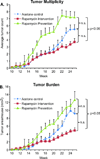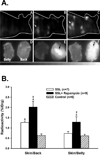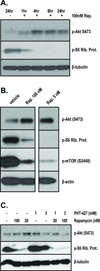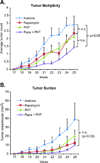Inhibition of Akt Enhances the Chemopreventive Effects of Topical Rapamycin in Mouse Skin
- PMID: 26801880
- PMCID: PMC4777684
- DOI: 10.1158/1940-6207.CAPR-15-0419
Inhibition of Akt Enhances the Chemopreventive Effects of Topical Rapamycin in Mouse Skin
Abstract
The PI3Kinase/Akt/mTOR pathway has important roles in cancer development for multiple tumor types, including UV-induced nonmelanoma skin cancer. Immunosuppressed populations are at increased risk of aggressive cutaneous squamous cell carcinoma (SCC). Individuals who are treated with rapamycin (sirolimus, a classical mTOR inhibitor) have significantly decreased rates of developing new cutaneous SCCs compared with those that receive traditional immunosuppression. However, systemic rapamycin use can lead to significant adverse events. Here, we explored the use of topical rapamycin as a chemopreventive agent in the context of solar-simulated light (SSL)-induced skin carcinogenesis. In SKH-1 mice, topical rapamycin treatment decreased tumor yields when applied after completion of 15 weeks of SSL exposure compared with controls. However, applying rapamycin during SSL exposure for 15 weeks, and continuing for 10 weeks after UV treatment, increased tumor yields. We also examined whether a combinatorial approach might result in more significant tumor suppression by rapamycin. We validated that rapamycin causes increased Akt (S473) phosphorylation in the epidermis after SSL, and show for the first time that this dysregulation can be inhibited in vivo by a selective PDK1/Akt inhibitor, PHT-427. Combining rapamycin with PHT-427 on tumor prone skin additively caused a significant reduction of tumor multiplicity compared with vehicle controls. Our findings indicate that patients taking rapamycin should avoid sun exposure, and that combining topical mTOR inhibitors and Akt inhibitors may be a viable chemoprevention option for individuals at high risk for cutaneous SCC.
©2016 American Association for Cancer Research.
Conflict of interest statement
The authors declare that they have no conflict of interest.
Figures






Similar articles
-
Photocarcinogenesis study of glycolic acid and salicylic acid (CAS Nos. 79-14-1 and 69-72-7) in SKH-1 mice (simulated solar light and topical application study).Natl Toxicol Program Tech Rep Ser. 2007 Sep;(524):1-242. Natl Toxicol Program Tech Rep Ser. 2007. PMID: 21921960
-
Rapamycin-mediated mTOR inhibition attenuates survivin and sensitizes glioblastoma cells to radiation therapy.Acta Biochim Biophys Sin (Shanghai). 2011 Apr;43(4):292-300. doi: 10.1093/abbs/gmr012. Epub 2011 Mar 1. Acta Biochim Biophys Sin (Shanghai). 2011. PMID: 21367753
-
Inhibition of mTOR by apigenin in UVB-irradiated keratinocytes: A new implication of skin cancer prevention.Cell Signal. 2016 May;28(5):460-468. doi: 10.1016/j.cellsig.2016.02.008. Epub 2016 Feb 12. Cell Signal. 2016. PMID: 26876613 Free PMC article.
-
Topical use of mammalian target of rapamycin inhibitors in dermatology: A systematic review with meta-analysis.J Am Acad Dermatol. 2019 Mar;80(3):735-742. doi: 10.1016/j.jaad.2018.10.070. J Am Acad Dermatol. 2019. PMID: 30744877
-
Topical rapamycin (sirolimus) for the treatment of uncomplicated tufted angiomas in two children and review of the literature.Pediatr Dermatol. 2018 Sep;35(5):e286-e290. doi: 10.1111/pde.13596. Epub 2018 Jul 17. Pediatr Dermatol. 2018. PMID: 30015406 Review.
Cited by
-
Molecular signaling cascades involved in nonmelanoma skin carcinogenesis.Biochem J. 2016 Oct 1;473(19):2973-94. doi: 10.1042/BCJ20160471. Biochem J. 2016. PMID: 27679857 Free PMC article. Review.
-
Increased PD-L1 Expression in Human Skin Acutely and Chronically Exposed to UV Irradiation.Photochem Photobiol. 2021 Jul;97(4):778-784. doi: 10.1111/php.13406. Epub 2021 Mar 10. Photochem Photobiol. 2021. PMID: 33615483 Free PMC article.
-
Pharmacological TLR4 Antagonism Using Topical Resatorvid Blocks Solar UV-Induced Skin Tumorigenesis in SKH-1 Mice.Cancer Prev Res (Phila). 2018 May;11(5):265-278. doi: 10.1158/1940-6207.CAPR-17-0349. Epub 2018 Feb 1. Cancer Prev Res (Phila). 2018. PMID: 29437671 Free PMC article.
-
Resatorvid-based Pharmacological Antagonism of Cutaneous TLR4 Blocks UV-induced NF-κB and AP-1 Signaling in Keratinocytes and Mouse Skin.Photochem Photobiol. 2016 Nov;92(6):816-825. doi: 10.1111/php.12659. Epub 2016 Dec 8. Photochem Photobiol. 2016. PMID: 27859308 Free PMC article.
-
Skin cancer: understanding the journey of transformation from conventional to advanced treatment approaches.Mol Cancer. 2023 Oct 6;22(1):168. doi: 10.1186/s12943-023-01854-3. Mol Cancer. 2023. PMID: 37803407 Free PMC article. Review.
References
-
- Liu LS, Colegio OR. Molecularly targeted therapies for nonmelanoma skin cancers. Int J Dermatol. 2013;52:654–665. - PubMed
-
- Wondrak GT. Sunscreen-based skin protection against solar insult: molecular mechanisms and opportunities. Fundamentals of Cancer Prevention. 2014;30:301–320.
-
- Natarajan VT, Ganju P, Ramkumar A, Grover R, Gokhale RS. Multifaceted pathways protect human skin from UV radiation. Nat Chem Biol. 2014;10:542–551. - PubMed
-
- Housman TS, Feldman SR, Williford PM, Fleischer AB, Jr, Goldman ND, Acostamadiedo JM, et al. Skin cancer is among the most costly of all cancers to treat for the Medicare population. J Am Acad Dermatol. 2003;48:425–429. - PubMed
-
- American Cancer Society. Cancer Facts & Figures 2013. American Cancer Society; 2013.
Publication types
MeSH terms
Substances
Grants and funding
LinkOut - more resources
Full Text Sources
Other Literature Sources
Medical
Molecular Biology Databases
Research Materials
Miscellaneous

